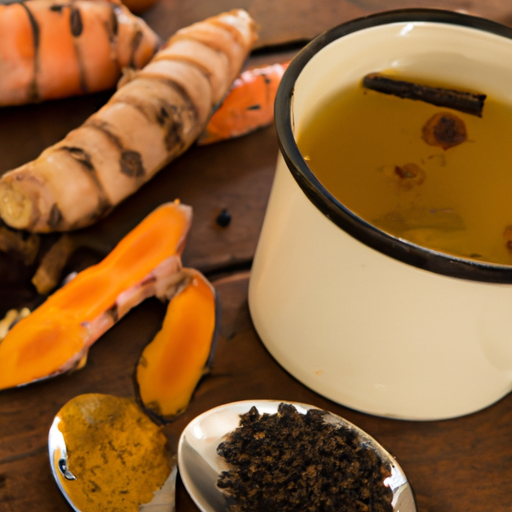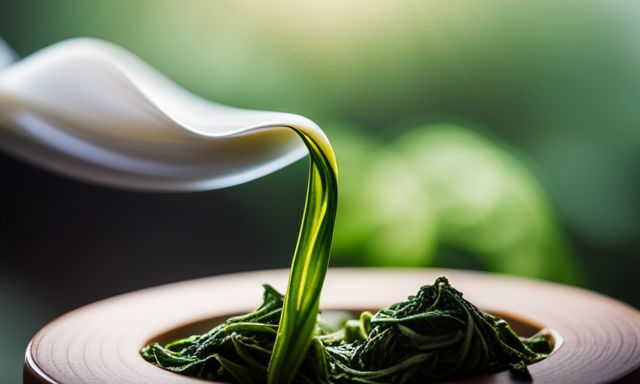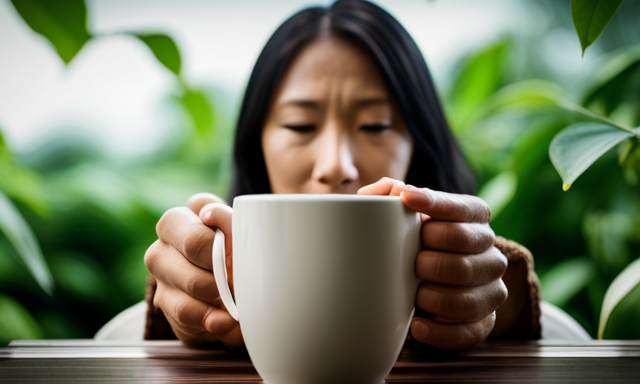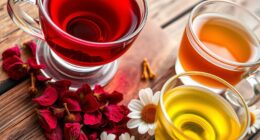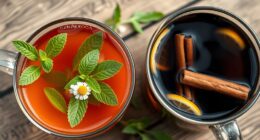Have you ever wondered how oolong tea tastes? It’s a question that has intrigued tea enthusiasts for centuries. As a lover of this exquisite beverage, I have explored the depths of oolong tea’s flavor and am here to share my findings with you.
Oolong tea, with its origins in China and Taiwan, is known for its complex and nuanced taste. Its flavor profile is a delicate balance of floral notes, subtle sweetness, and a hint of earthiness.
The taste of oolong tea varies depending on factors such as oxidation level and terroir, giving rise to a wide range of flavors, from fruity and creamy to grassy and vegetal. Brewing technique also plays a crucial role in enhancing the taste, ensuring a perfect cup every time.
Join me on this journey as we delve into the world of oolong tea and discover the sensory delights it has to offer.
Key Takeaways
- Oolong tea has a complex and captivating taste with delicate floral and fruity undertones.
- It has a rich and velvety mouthfeel with a smooth and luscious texture.
- Oolong tea leaves a satisfying and indulgent sensation, enhancing the taste of desserts with subtle hints of orchid and honey.
- It offers health benefits such as high antioxidant content, boosted metabolism, improved digestion, and overall well-being.
The Origins and Production of Oolong Tea
Oolong tea is a unique blend of black and green teas, with a flavor that dances between rich and earthy. Its origins can be traced back to the Fujian province in China, where it has been produced for centuries.
The production process involves withering the leaves under the sun and allowing them to partially oxidize before they are heated to stop the oxidation process. This careful balance between oxidation and heat gives oolong tea its distinct flavor profile.
The leaves are then rolled into tight, twisted shapes, which further enhances the tea’s complexity. As a result of this intricate production method, oolong tea offers a delightful combination of floral and aromatic notes alongside its rich and earthy undertones.
These nuances make oolong tea a truly captivating beverage that offers a sensory journey with every sip.
Aromatic and Floral Notes in Oolong Tea
With its delicate and fragrant bouquet, oolong tea boasts aromatic and floral notes that captivate the senses. The complexity of its flavor profile is a result of the intricate process of production. Here are three key elements that contribute to the tantalizing aroma and floral undertones of oolong tea:
-
Oxidation: The level of oxidation during production determines the intensity and depth of the tea’s aroma. Oolong tea is partially oxidized, allowing it to strike a perfect balance between the freshness of green tea and the richness of black tea.
-
Roasting: The leaves of oolong tea are often roasted, adding a layer of toasty and nutty aromas to the brew. This additional step enhances the complexity of the fragrance, creating a captivating olfactory experience.
-
Floral Varieties: Different varieties of oolong tea, such as Tie Guan Yin or Oriental Beauty, possess their own distinct floral notes. These unique flavors arise from the specific cultivars used and the terroir in which the tea is grown.
These aromatic and floral qualities pave the way for the subsequent section, exploring the subtle and complex flavor profiles of oolong tea.
Subtle and Complex Flavor Profiles
Step into a mystical garden, where your taste buds embark on a whimsical journey through layers of intricate flavors and subtle nuances that dance upon your palate.
Oolong tea, with its nuanced and complex flavor profiles, offers a truly unique sensory experience. As a tea enthusiast, I have explored various brewing techniques to unlock the full potential of oolong tea’s taste.
The delicate leaves, carefully hand-picked and artfully processed, yield a brew that is both fragrant and flavorful. Each sip reveals a medley of floral, fruity, and woody notes, intertwining harmoniously to create a symphony of flavors.
Not only does oolong tea offer a delightful taste experience, but it also boasts numerous health benefits, from boosting metabolism to promoting heart health.
Now, let’s delve into the role of oxidation in oolong tea taste, as it further enhances the complexity of this exceptional beverage.
The Role of Oxidation in Oolong Tea Taste
Embark on a journey through the depths of flavor in oolong tea as oxidation plays a vital role in creating a taste experience like no other.
When it comes to oolong tea, oxidation holds the key to unlocking its exquisite aroma. As the tea leaves undergo partial oxidation, they develop complex and alluring scents, ranging from floral and fruity to woody and nutty. This process gives oolong tea its signature fragrance, enticing the senses with every sip.
But oxidation does more than just enhance the aroma of oolong tea; it also contributes to its health benefits. During oxidation, chemical compounds called catechins are transformed into theaflavins and thearubigins, which are known for their antioxidant properties. These compounds help protect the body against harmful free radicals and promote overall wellness.
As we delve further into the flavors of oolong tea, let us now explore the influence of terroir on its captivating taste experience.
The Influence of Terroir on Oolong Tea Flavor
Hailing from different regions, oolong tea leaves acquire distinctive flavors influenced by the unique characteristics of their terroir. The role of climate in terroir cannot be underestimated, as it shapes the flavor profile of oolong tea. Each region’s climate, whether it be warm and humid or cool and misty, imparts its own nuances to the tea leaves.
Furthermore, the influence of elevation on flavor adds another layer of complexity. Oolong teas grown at higher elevations tend to have a lighter and more delicate taste, while those grown at lower elevations possess a richer and more robust flavor. The interplay between climate and elevation results in a diverse range of oolong tea flavors, from floral and fruity to earthy and nutty.
As we delve into the next section about the balance of sweetness and bitterness in oolong tea, we will further explore the intricate taste profiles that make this tea so captivating.
The Balance of Sweetness and Bitterness in Oolong Tea
Delving into the realm of oolong tea flavors, one cannot help but be captivated by the delicate dance between sweetness and bitterness.
Oolong tea is renowned for its unique balance of these contrasting elements, creating a flavor profile that is both complex and intriguing.
The sweetness in oolong tea can range from floral and fruity notes to honey-like undertones, providing a pleasant and lingering taste on the palate.
On the other hand, the bitterness adds depth and character to the overall experience, enhancing the tea’s richness.
It is this intricate interplay between sweetness and bitterness that makes oolong tea so captivating and enjoyable to savor.
As we transition to the next section about the grassy and vegetal undertones in oolong tea, we continue to explore the multifaceted nature of this exceptional beverage.
Grassy and Vegetal Undertones in Oolong Tea
The grassy and vegetal undertones of oolong tea transport you to a lush garden, where each sip awakens your senses with a vibrant and refreshing burst of nature’s essence. As you take a sip, a wave of flavors washes over your palate, revealing the intricate dance between the grassy flavor and delicate floral undertones. The grassy notes provide a crisp and fresh taste, reminiscent of a morning dew-kissed meadow. Meanwhile, the floral undertones add a subtle sweetness, like the fragrance of blooming flowers in the air. It’s a harmonious combination that creates a truly captivating experience for your taste buds.
In the next section, we will explore the importance of brewing technique in enhancing the taste of oolong tea, delving into the art of unlocking its full potential.
The Importance of Brewing Technique in Enhancing Taste
To truly unlock the full potential of oolong tea, mastering the art of brewing technique is essential. It is the key that unlocks a world of enhanced flavors and sensory delights. Exploring different brewing methods allows for a deeper understanding of the intricate nuances that oolong tea has to offer.
By adjusting the water temperature, one can manipulate the taste profile of the tea, extracting different notes and aromas. Steeping at a higher temperature may result in a bolder, more robust flavor, while a lower temperature can bring out delicate floral or fruity undertones. Understanding the impact of water temperature is crucial in creating the perfect cup of oolong tea.
As we delve into the next section, we will further explore oolong tea’s mouthfeel and texture, completing our sensory journey through this exquisite beverage.
Oolong Tea’s Mouthfeel and Texture
Experience the rich and velvety mouthfeel of oolong tea. Allow your taste buds to luxuriate in its smooth and luscious texture. With your first sip, a wave of silkiness envelops your palate. It leaves behind a lingering sensation that is both satisfying and indulgent.
The mouthfeel of oolong tea is a testament to its meticulous crafting process. The leaves are partially oxidized, resulting in a complex and captivating flavor profile. This unique texture is complemented by the tea’s mesmerizing aroma. It fills the air with hints of floral and fruity notes, adding another layer of sensory delight.
Now, let’s delve into the art of pairing oolong tea with food for a complete taste experience. Culinary delights meet the exquisite flavors of this remarkable tea.
Pairing Oolong Tea with Food for a Complete Taste Experience
Indulge your palate with the perfect pairing of oolong tea and delectable dishes, creating a harmonious symphony of flavors that will transport you to culinary bliss.
When it comes to pairing oolong tea with desserts, the possibilities are endless. The delicate floral notes and slightly sweet undertones of oolong tea beautifully complement desserts like fruit tarts, crème brûlée, and chocolate truffles. Each bite is enhanced by the tea’s subtle hints of orchid and honey, creating a truly decadent experience.
But the benefits of oolong tea extend beyond just its taste. Known for its high antioxidant content, oolong tea can boost metabolism, aid in digestion, and promote overall well-being. So, while you savor the exquisite flavors of your favorite desserts, you can also feel good knowing that you are nourishing your body.
Frequently Asked Questions
How many different varieties of oolong tea are there?
There are numerous varieties of oolong tea, each with its own unique flavor profile. From the delicate floral notes of green oolong to the rich, roasted flavors of dark oolong, there is a wide range to explore and enjoy.
Can oolong tea be brewed multiple times?
Yes, oolong tea can be brewed multiple times using different brewing techniques. The oolong tea leaves retain their flavor and aroma, allowing for a rich and satisfying experience with each infusion.
Does oolong tea have any health benefits?
"Oolong tea, a delightful elixir for both taste buds and waistlines, offers a plethora of health benefits. From boosting metabolism to aiding in weight loss, this fragrant brew is a true gift from nature."
What is the caffeine content in oolong tea compared to other types of tea?
The caffeine content in oolong tea is moderate compared to other types of tea. Oolong tea offers numerous health benefits, such as boosting metabolism and promoting heart health.
Can oolong tea be consumed iced or is it best served hot?
Oolong tea can be consumed iced or served hot, depending on personal preference. While some enjoy the refreshing and crisp taste of iced oolong, others appreciate the rich and complex flavors that are best experienced when served hot.
Conclusion
In conclusion, the taste of oolong tea is a symphony of flavors that dance on the palate. Each sip offers a journey of taste, from delicate floral notes to subtle grassy undertones. The art of brewing oolong tea is crucial in extracting its full potential, allowing for a complete taste experience.
As the Chinese proverb goes, ‘A cup of oolong tea is like a journey to the mountains, refreshing both the body and the soul.’ So, embark on this sensory adventure and indulge in the exquisite taste of oolong tea.


